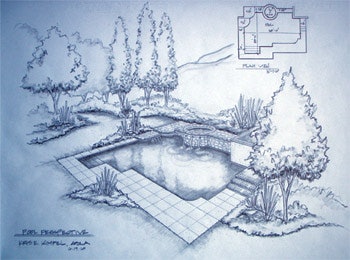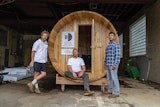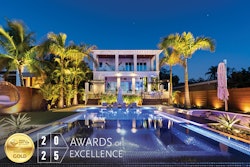
Welcome to the first installment of AQUA Architecture, a brand-new special section covering the cutting edge of aquatic design and construction – content we hope will inspire and educate those who create all forms of recreational, therapeutic and decorative bodies of water.
The plan for this new editorial journey was first plotted back in July when Publisher Shawn Gahagan and Executive Editor Scott Webb asked me to join the AQUA team to help expand the magazine's content into this exciting and dynamic segment of the industry. The basic premise: to explore the world of top-flight design and construction in an effort to upgrade our industry's performance and increase overall customer satisfaction. No small task, but certainly one well worth the effort.
Some of you may know me from my past work with other industry magazines including Pool & Spa News and most recently WaterShapes. Throughout my career covering all things aquatic, I've always admired AQUA and especially the people behind the magazine, so I was thrilled to take on this new challenge.
And a challenge it shall be; one coming at a time when our industry stands at a crucial crossroads, a point of collective reckoning that is certain to shape the future. It's no secret the recession has had a massive impact on the nature of the pool and spa industry and as we look toward better days there can be little doubt that what will emerge on the other side of this economic abyss will be very different from the industry we'd known prior to the collapse.
Changing Spaces
Even before the recent epic downturn, the industry was already in a state of dramatic transformation. Where pools and spas were once largely utilitarian in design, they began to noticeably evolve sometime just prior to the turn of the millennium. A new breed of designers and builders began replacing the old rank and file, creating daring new projects that became more than just man-made bodies of water, but entire recreational environments. Associated features such as ponds and streams, fountains, interactive waterfeatures and outdoor dining and entertaining areas became far more prevalent among many other innovations.
Landscape architects and others from outside the industry became far more involved in aquatic design and in a flurry of creative expansion fueled by a then strong economy a new type of industry emerged. Clients began looking at their outdoor spaces as potential private resorts where their functional living spaces would now include outdoor "rooms." The aging Baby Boomers' hunger for healthy lifestyles combined with the desire in the post-911 era to keep kids at home and families more tightly together further stoked the trend.
With all those factors driving change, the very best pools, spas and other types of aquatic features became a new kind of architectural art form. Daring edge designs, water-in-transit schemes and an ever-expanding palette of materials redefined and expanded the spectrum of creative possibilities. Projects ranging into the six and even seven figures became commonplace in what seemed like a sort of arms race of exterior design luxury.
Leading the way in this expansion were three very close friends of mine, David Tisherman, Skip Phillips and Brian Van Bower, the founders of the revolutionary Genesis 3 Design Schools. Affectionately known by their friends and associates as the "Three Pigs," they effectively established a new value system for the industry, with educational offerings focusing on the principles of design, engineering and construction. The industry had never seen anything like it before and within a very short period of time Genesis 3 became the standard bearer of a new era.
For my part, I'm proud to have played a part in this revolution by way of my 12-year tenure as editor of WaterShapes, which in essence reflected in print much of what Genesis 3 worked to achieve in the classroom. But, as they say, all things must pass and circumstances compelled me to move along toward new ventures.
A Fresh Start
Right after I started working with the AQUA staff, I had an opportunity to spend a day away from my home office touring a number of David Tisherman's recent projects, all located within southern California's very most upscale neighborhoods. It's something I'd done with him many times in the past and I've always enjoyed seeing the amazing work he does and watching the unique way that he goes about his business.
As we were driving between stops, Tisherman shared with me what he sees as the core conceptual structure of Genesis 3, a manifesto of sorts that he believes is the key to success when it comes to creating beautiful, custom residential pools and associated environments. He called it the ABCs: "A" for artistry, "B" for business and "C" for construction. To become truly accomplished, to reach beyond the status quo and unlock your full potential, you must master all three.
According to Tisherman, shortcomings in any of these three critical areas will bring down the entire concept.
For those who know Tisherman, it will come as no surprise that he delivered this discussion with an almost ferocious level of passion. For those who haven't had the pleasure, I can assure you this is a man who does not spare any means of verbal expression. (It's a little bit like getting hit in the forehead with a two-by-four, but for your own good.)
Suffice to say that sometimes listening to an infamous "Tisherman rant" is enough to make one break a sweat. And on this warm July day, as the beads were forming on my forehead and the burning sensation increasing in my ears, I had to acknowledge that he is absolutely right about what it takes to become a great pool designer and builder; because at the core of his ABCs resides one very important word – education.
Classroom Conundrums
Certainly, advocacy of education is nothing new and for decades many industry leaders have time and time again extolled the virtues of upgrading the industry's level of professional instruction. Some would argue that much of that rhetoric has not been followed by substance, while others will say that the industry has made strides in the right direction. Personally, I see truth on both sides of the discussion.
But herein lies the proverbial rub. Despite widespread consensus that the path to a better future for the industry is education, despite the presence of Genesis 3 and expanded offerings at trade shows and various symposia, there is no university course in aquatic construction, no sheepskin awarded for learning how to build pools, fountains and other aquatic features. There simply is no such thing in the world of academia as "AQUA Architecture."
Certainly, there are those who have tried to move things in that direction: Tisherman, for example, teaches swimming pool design in an extension course for landscape architecture students at UCLA, and another close friend of mine, Mark Holden has taught week-long "water modules" also to landscape architecture students at his alma mater, Cal Poly Pomona.
Yet, with those efforts and other scattered attempts, the conundrum remains that an industry whose future must be defined by education, it is not supported in any widespread way by formal university-level training. The ugly truth is that everyone in the pool and spa industry must inevitably transfer educational experiences from other areas, be it structural engineering, industrial design, interior design, landscape design, architecture and most commonly the "school of hard knocks."
Ours is, ultimately, a sort of hand-me-down industry where there is no standard for knowledge, no accreditation that demonstrates a base level of training. This has led to an industry dominated by the "we've always just done it that way" mentality, where often-erroneous information is passed down from generation to generation, in some cases allowing false gurus to stake out their territory based on the flimsiest idea and skill sets.
Stepping Up
Throughout my years plying my own journalistic trade in the world of recreational and decorative water, many people have complained that it's almost fashionable to slam the industry, but rare that anyone does anything about it other than complain.
That is true to an extent, but it's also true that our industry does have some shining exceptions. In addition to the work of Genesis 3, other organizations such as the National Swimming Pool Foundation, The National Plasterers Council, the International Swimming Hall of Fame and a handful of others have created some wonderful programs. As a result we do have improved standards for safety, construction, chemistry and quality control, as well as a far greater understanding of the benefits of aquatic exercise.
It's also useful to keep in mind that a migration of landscape architects have come into the industry bringing their own related backgrounds to the table. Many of these professionals have in recent years created some of the most beautiful of projects, demonstrating in tangible ways that design education can and does make a difference.
I've long believed that there are people within our industry who are dedicated to advancing the cause of professional education, no question. The problem, however, has been and remains the fractured and scattered nature of these efforts. There is a broad set of disconnects that disrupts any movement toward broader coalescence and now with the industry floundering financially in many sectors, the impetus to move forward has clearly lost a large measure of momentum.
All of this leads back to the notion that we are at a crossroads, that we are here at a time and place where the future is wildly uncertain, where the choices we make today, the values we choose to embrace or ignore may very well set the stage for years and years to come. Fact is, there are no easy answers to any of this, but here in these pages, I can assure you that we will work to reveal the type of information that can help push toward a future of unlimited potential.
And we'll do it by starting with the ABCs.
Comments or thoughts on this article? Please e-mail [email protected].












































